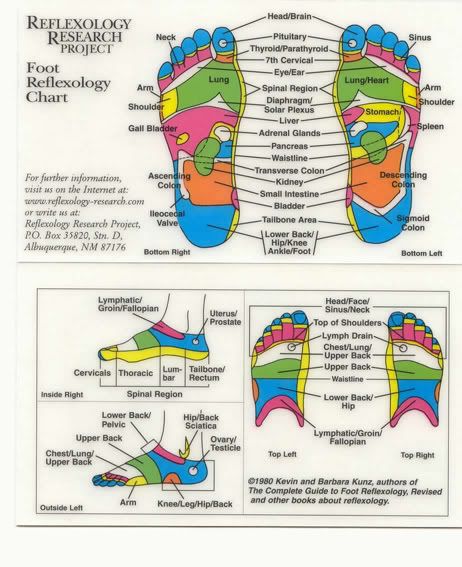Reflexology works by interrupting stress patterns in the body, through stimulating pressure sensors on the hands and feet that induce a specific relaxation response in the corresponding body part.
This in turn is said to reduce stress in the nervous system, promoting beneficial effects on the whole body.
The goal is to lower your stress sufficiently to allow your body to begin to repair itself.
"Sophisticated measuring devices used by researchers in Singapore have shown in one study that reflexology impacts heart health," he adds.
"Another study also showed that reflexology work produces the same effects in the brain as those produced by an individual who is meditating.
Both studies used the real-time measurement of reflexology work with an EKG and an EEG respectively."
Hands and feet
While obviously not exactly the same process, hand and foot reflexology are linked, with the hand reflexology map mirroring the foot reflexology map.
Some consider foot reflexology to be the more effective practice, because the shoe-wearing foot is more protected and therefore more sensitive to reflexology work.
However, hands have the benefit of being more easily accessible and therefore available for more frequent reflexology work.
"Research has shown a foot-to-hand link so that hand reflexology can be very effective for the same issues addressed by foot reflexology," explains Kevin.
"Hand reflexology may be easier to learn, simply because most of us are more accustomed to handling and working with our hands rather than our feet.
One of the great things about hand reflexology is that it is simple, effective and safe."
Reflexology can help to feel make you more relaxed all over
Reflexology can help to feel make you more relaxed all over
Easy
Getting started in hand reflexology is easy, he says.
Pressure, stretch and movement are your tools to use for a happier hand and a healthier you. Pull gently on a finger. Press the webbing of your hand between thumb and fingertip.
Grasp the body of the hand and move it from side to side. Any such activities provide a bit of respite. "One caveat is tailoring one's enthusiasm for reflexology work to match the hand's capabilities," Kevin warns.
In other words, don't get carried away by overly working your hands when applying reflexology technique. It is important that the technique be kept within the recipient's comfort zone.
"Overuse can result from the application of technique that is too much, too long or too hard," Kevin adds.
"If part of the hand feels unduly sensitive to the touch following reflexology work, rest it for a few days before resuming work.
Lessen the time and frequency of application but if the hand is still sensitive, stop."
As well as simply using your hand for manipulation, traditional massage tools such as foot rollers can also be used.
However, Kevin's favourite is a golf ball. "Grasp the hands together, holding a golf ball between the hands, and then roll the ball throughout the palm below the thumb," he explains.
"This simple technique helps one apply pressure to reflex areas reflecting parts of the body significant to one's well-being.
These include the energy producing adrenal glands and pancreas, the stress relieving solar plexus as well as the major organs, the kidneys and stomach.
[img width=429 height=500]http://i31.photobucket.com/albums/c373/awanix/handchart.jpg[/img]
Results 1 to 10 of 47
Thread: Reflexology
-
01-28-2007, 12:33 AM #1
 Reflexology
Reflexology
-
01-28-2007, 12:36 AM #2
-
01-28-2007, 12:37 AM #3
-
01-28-2007, 12:45 PM #4
 Re: Reflexology
Re: Reflexology
naa kay nahibal-an bai awan asa nindot magpa reflexology?
-
01-28-2007, 12:49 PM #5
 Re: Reflexology
sa mga PT(Physical therapist) bai..pero mahal pud lage ila bayad..pwede mn ikaw2x nlng..try to locate lng if were na
Re: Reflexology
sa mga PT(Physical therapist) bai..pero mahal pud lage ila bayad..pwede mn ikaw2x nlng..try to locate lng if were na Originally Posted by Bahalina-boy
Originally Posted by Bahalina-boy
pressing points imo gusto sa kamot ba o tiil..xample, if labad imo ulo, pangitaa lng wer ang pressing points para sa ulo, dn i press lng dyon pirmi..for a while mawala ra dyon ang labad..
-
01-28-2007, 12:58 PM #6
 Re: Reflexology
Re: Reflexology
usahay galeh ako raman mo pislit2x sa ako tiil nindot kaau ang feeling bai awan. labina kung lain tao kay igo raka mag relax2x..

akong pina ka ganahan jud na pressing point kay sa Pituitary og Thyroid.
-
01-28-2007, 01:11 PM #7
 Re: Reflexology
preho tah bai..pituitary jpon ang ako..
Re: Reflexology
preho tah bai..pituitary jpon ang ako.. Originally Posted by Bahalina-boy
Originally Posted by Bahalina-boy
mas nindot f uyab nimo ang mopislit..heheheh
-
01-31-2007, 10:54 AM #8Junior Member

- Join Date
- Dec 2006
- Posts
- 145
 Re: Reflexology
Re: Reflexology
naa daghan diha atbang sa catheral.. donations lang.. pero expect daan mag ping-it ka sa kasakit

-
01-31-2007, 07:25 PM #9Newbie

- Join Date
- Jan 2007
- Posts
- 19
 Re: Reflexology
Re: Reflexology
hmmm....dont forget aceite de alcaniforado ointment :mrgreen:
-
02-01-2007, 12:38 AM #10
 Re: Reflexology
asa man dapita na?
Re: Reflexology
asa man dapita na? Originally Posted by philvault
Originally Posted by philvault
Advertisement
Similar Threads |
|







 Reply With Quote
Reply With Quote
